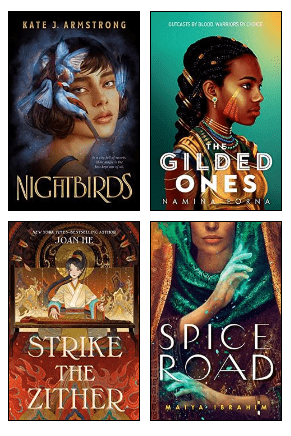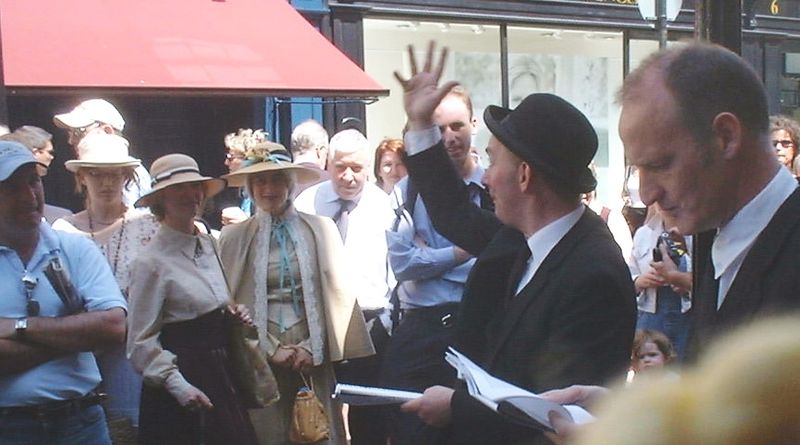 The cover of the young adult fantasy novel Nightbirds by Kate J. Armstrong reliably hints at the promise and magic of the story that lies within while also seeking to differentiate itself in a saturated market. Not only is the artwork attractively rendered, but it shows the emotion and supernatural abilities of the character Matilde with symbolism attached to the particular bird associated with her in the novel: the goldfinch. This portrayal of Matilde brings the reader's attention to her beauty and lips — the main characters' kisses are the means by which they convey their magic to others. At the same time, her eyes are drawn in a way that evokes the sadness and yearning she feels as she comes of age and fights to establish her own power against years of entrenched oppression. This imagery and the cover as a whole reflect many current trends in young adult fantasy.
The cover of the young adult fantasy novel Nightbirds by Kate J. Armstrong reliably hints at the promise and magic of the story that lies within while also seeking to differentiate itself in a saturated market. Not only is the artwork attractively rendered, but it shows the emotion and supernatural abilities of the character Matilde with symbolism attached to the particular bird associated with her in the novel: the goldfinch. This portrayal of Matilde brings the reader's attention to her beauty and lips — the main characters' kisses are the means by which they convey their magic to others. At the same time, her eyes are drawn in a way that evokes the sadness and yearning she feels as she comes of age and fights to establish her own power against years of entrenched oppression. This imagery and the cover as a whole reflect many current trends in young adult fantasy.

Between autumn 2020 and spring 2021, lots of COVID-themed books started to appear on bookstore and library shelves in the UK, where I live. It felt like nonfiction was quicker to respond to the pandemic than fiction. Some of my favorites were too niche for US publication because they focus on the UK’s National Health Service (Intensive Care by Gavin Francis, a Scottish GP) or England’s lockdown spring (The Consolation of Nature by Michael McCarthy, Jeremy Mynott, and Peter Marren). It soon became a low-key obsession of mine to read whatever I could about COVID.
I’ve especially valued insider looks by medical professionals. Every Minute Is a Day by Robert Meyer, MD and Dan Koeppel is a blow-by-blow account of the first six months of the pandemic by an ER doctor at the Bronx’s Montefiore Medical Center. The statistics are stark: Of 6,000 COVID-19 patients admitted between March and September 2020, nearly 1,000 died. The situation changed daily as doctors recognized new symptoms and tested treatments.
 Kalani Pickhart's debut novel I Will Die in a Foreign Land follows four central characters through the tumultuous days of Ukraine's Euromaidan protests that took place between November 2013 and February 2014. The protests are so named because they were centered on Kyiv's Maidan Nezalezhnosti (Independence Square) and were triggered by then President Viktor Yanukovych's refusal to sign an agreement with the European Union that had been overwhelmingly approved by Ukraine's parliament. The protesters also opposed the overt and widespread corruption of Yanukovych and his ministers.
As a result of the protests, an agreement was signed in late February 2014 by Yanukovych that called for the creation of an interim government, constitutional reforms and early elections. Shortly after, Yanukovych and his ministers fled to Russia, and Russia annexed Crimea and the Donbas region.
Kalani Pickhart's debut novel I Will Die in a Foreign Land follows four central characters through the tumultuous days of Ukraine's Euromaidan protests that took place between November 2013 and February 2014. The protests are so named because they were centered on Kyiv's Maidan Nezalezhnosti (Independence Square) and were triggered by then President Viktor Yanukovych's refusal to sign an agreement with the European Union that had been overwhelmingly approved by Ukraine's parliament. The protesters also opposed the overt and widespread corruption of Yanukovych and his ministers.
As a result of the protests, an agreement was signed in late February 2014 by Yanukovych that called for the creation of an interim government, constitutional reforms and early elections. Shortly after, Yanukovych and his ministers fled to Russia, and Russia annexed Crimea and the Donbas region.
In anticipation of the publication of Sally Rooney's Beautiful World, Where Are You September 7, we invite you to take a tour of Dublin from a literary perspective with our "beyond the book" article:
 The backdrop of Sally Rooney's Beautiful World, Where Are You is the city of Dublin and its environs. Rooney herself lives in this UNESCO City of Literature, a metropolis that boasts a flourishing literary scene and an impressive inventory of influential authors, poets and playwrights. The streets of the vibrant capital are infused with the presence of its bookish greats, with landmarks never more than a few minutes away.
The backdrop of Sally Rooney's Beautiful World, Where Are You is the city of Dublin and its environs. Rooney herself lives in this UNESCO City of Literature, a metropolis that boasts a flourishing literary scene and an impressive inventory of influential authors, poets and playwrights. The streets of the vibrant capital are infused with the presence of its bookish greats, with landmarks never more than a few minutes away.
Jhumpa Lahiri wrote her novel Whereabouts in Italian, a language she learned in adulthood, and later translated it into English. Many authors have at some time made the decision to become exophonic (to write in a language other than one's native tongue), whether for personal, artistic, practical or political reasons.
The author who is possibly best known for doing this is Irish writer Samuel Beckett, who famously adopted French in order to write "sans style" (without style). While he eventually returned to English, some of his most famous works were originally composed in French, including the play En attendant Godot (Waiting for Godot) and the trilogy of novels beginning with Molloy.
2019 was a year of literary sequels: bestselling authors expanding on fictional worlds they created, in some cases decades after the original book was published. Find Me by André Aciman is one such example, published 12 years after Call Me By Your Name. But it's hardly a new phenomenon—here are some of the most noteworthy literary sequels to have hit the shelves, often to the surprise and delight of readers everywhere.